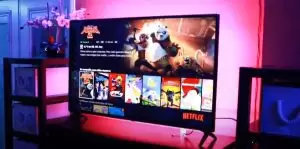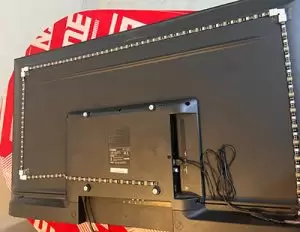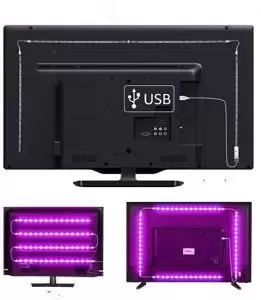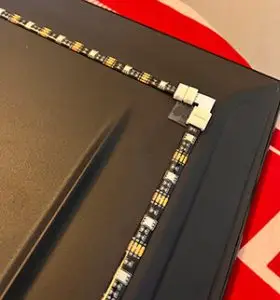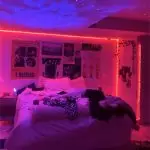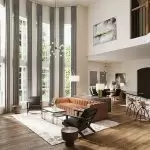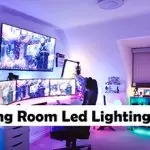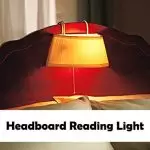Are you a fan of binge-watching your favorite TV shows in a dark room? It’s an awesome way to get completely immersed in the story and feel like you’re part of the action. But let’s face it – this habit can cause some serious issues like eye strain, dry eyes, and even migraines.
Like many others, I’ve faced these problems before but discovered an effective solution: installing LED lights on the back of our TV. The bias lighting coming from the LED lights not only tackles all the problems but also adds ambient illumination around your screen enhancing your content consumption experience.
If you don’t know how to install LED light strips on the back of the TV, don’t worry – I have got you covered. I’ll walk you through the installation process for both LED light bars and strips, so that you can have a seamless and hassle-free installation experience.
How To Choose The Best LED Lights For Your TV: Buyer’s Guide
When it comes to adding LED lights to your TV, you have two options to choose from – LED light strips or LED light bars.
From these two options, LED light strips deserve a dedicated guide on choosing the best ones. Check the following factors before purchasing your LED light strip:
Table of Contents
- Type Of LED Light Strip
- Length Of The Led Light Strip
- RGB Vs. RGBIC
- Avoid Waterproof LED Light Strip
- Adjustable Brightness
- Adhesive Options/Quality
- How To Install LED Light Strip Behind Tv: 7 Steps Guide
- Step 1: Measure Your TV & Choose Your Light Options
- Step 2: Prepare The TV & Surface For Installations
- Step 3: Decide Your Method For Arranging LED Light Strip
- Step 4: Peel & Stick
- Step 5: Handle The Corners Correctly
- Step 6: Power Your LED Lights
- Step 7: Relocate & Turn On Your TV for LED Strip Inspection
- Step 1: Select Your LED Light Bar
- Step 2: Select Your Preferable Placement
- Step 3: Route The Power Cord
- Step 4: Turn On Your TV For LED Light Bar Inspection
- Frequently Asked Questions – FAQs
Type Of LED Light Strip
LED light strips come in a variety of types and prices. Before making your purchase, it’s important to determine which type of LED light strip will best meet your needs.
For example, if you enjoy listening to music while watching TV, a light strip with music sync may be a good choice as it will synchronize with the beat of the music.
Similarly, if you want your lights to change in accordance with what’s happening on the screen, a light strip with content sync may be a great option. Make sure to consider your preferences and needs before deciding which LED light strip to purchase.
Length Of The Led Light Strip
When it comes to choosing LED light strips for your TV, size matters. You might find that the available strip lengths don’t quite match up with the size of your TV, which means you’ll either have to cut them down or add some more to get the perfect fit.
But don’t worry, it’s easy to figure out exactly how much LED light strip you need. First, measure the height and width of your TV. Then, use the rectangular perimeter formula to calculate the required strip length:
Perimeter = 2 x (Tv Height + Tv Width)
Example TV’s Screen Sizes: 32”, 43”, 65”, 75” & 120”
- 32 Inch TV Size
To cover a 32” TV on all four back sides, you’ll need around 7.28 feet of LED strip lights.
If you measure your 32” TV, you’ll find out the width is about 28” and the height is about 15.7”. Keeping these two values in consideration, you’ll get a perimeter value of 87.4”.
However, strip sellers measure strips in feet most of the time. That’s why you should divide this inch value by 12. Doing that, you’ll get 7.28 feet.
- 43 Inch TV Size
To cover a 43” TV on all four back sides, you’ll need around 9.75 feet of LED strip lights.
A typical 43” TV has a width of 37.5” and height of 21”. The perimeter turns out to be 117 inches. By dividing it by 12, you’ll get 9.75 feet. So, you’ll need a strip length of 9.75 feet to cover your 43” TV.
- 65 Inch TV Size
To cover a 65” TV on all four back sides, you’ll need around 14.83 feet of LED strip lights.
The 65” TV comes with a width of 57” and height of 32”. By using these two values, you can measure the perimeter of a 65” TV and it’s 178 inches. That being said, you’ll need around 178/12 feet or 14.83 feet of strip length to cover the back of your TV.
- 75 Inch TV Size
To cover a 75” TV on all four back sides, you’ll need around 17 feet of LED strip lights.
The width and height of the 75 inch TV is 65” and 37”. The perimeter is 204 inches or 17 feet. Means, you’ll need a strip length of 17 feet to cover a 75” TV.
- 120 Inch TV Size
To cover a 120” TV on all four back sides, you’ll need around 27.3 feet of LED strip lights.
A 120 inch massive TV has a width of 105 inch and height of 59 inch. By measuring the perimeter, you’ll get a value of 328 inches or 27.3 feet. Therefore, you will require a strip length of 27.3 feet or 2 LED light strips since the maximum length of an LED light strip is 16 feet.
RGB Vs. RGBIC
Two types of LED light strips are most popular for TV and they are RGB & RGBIC, and both have their own pros & cons.
The main difference between RGB and RGBIC is that RGB can only display one color simultaneously, whereas RGBIC can simultaneously display multiple colours on one strip.
Unlike the RGB strip, you can’t cut the RGBIC strip according to your preference. That being said, both types of strip have their own benefits and you have to choose them carefully.
Avoid Waterproof LED Light Strip
A waterproof LED light strip features a silicone coating that aids in making the strip waterproof. However, this silicone coat can dim the LED light strip, making it unsuitable for indoor use.
That’s why you should avoid purchasing waterproof LED light strips for your TV. We made the mistake of purchasing a waterproof LED light strip for our TV and regretted it. Therefore, we advise you not to make the same mistake as we did.”
Adjustable Brightness
No matter what type of LED light strip you buy, make sure the brightness is adjustable. If the brightness is not adjustable, you’ll have a hard time coping with the built-in brightness every time you turn on the strips.
Adhesive Options/Quality
LED light strip features built-in adhesive for sticking them onto anything (TV, in this case). Consider buying LED light strip with good adhesive quality. Don’t worry if you fail to choose a good one as the double-sided tape or any other additional adhesive will get you covered.
How To Install LED Lights On the Back Of TV: LED Strips & Bar Guides
There are two LED lights options – LED light strip & LED light bar. Stay tuned as I’ll be covering both of their installation guides step by step.
How To Install LED Light Strip Behind Tv: 7 Steps Guide
Follow these steps to install your LED light bar properly:
Step 1: Measure Your TV & Choose Your Light Options
Get yourself a measuring tape and measure the height & width of your TV. Don’t forget to keep an extra 16 to 20 inches for the corners (will discuss it thoroughly in step 4).
Step 2: Prepare The TV & Surface For Installations
If you have a very large TV, installing LED light strips on the back of it can be difficult. In this case, you can place the TV lying on its face (upside down) and prepare the surface for installing the LED light strips. Remember to use a piece of cloth underneath the TV to prevent scratches on the TV screen.
Use rubbing alcohol and a damp cloth to clean the surface, so that LED light strip adhesive can remain effective for a long time.
Step 3: Decide Your Method For Arranging LED Light Strip
There are mainly three methods of arranging LED light strips in the back of a TV and they are: 1) Covering four corners, 2) Covering three corners, and 3) Doing Zigzag.
- Method 1: Covering Four Corners
If you have measured your strip length perfectly according to your TV screen size, you can apply this method of covering all the four corners. If you cover all the four corners of your TV, you won’t have a dark spot/corner when the LED light strip starts to illuminate.
- Method 2: Covering Three Corners
If you find your strip length is insufficient for covering all the four corners, or you’re trying to cover a 55 inch TV with a strip length of a 32 inch TV – then you can apply this method of covering three corners. Make sure to keep the bottom side empty, as it won’t affect the overall lighting.
- Method 3: Doing ZigZag
This zigzagging method will suit best to those who have more strip length than needed, and don’t want to trim them. If you implement this method, you will have an even brighter background lighting effect and it will look awesome.
Step 4: Peel & Stick
After preparing your TV and the surface for installation:
- Choose the location from where you want to start sticking your LED light strip.
- Keep the starting point as close to the power port (USB/HDMI) as possible.
- Peel the adhesive and gently stick it throughout the back of your TV.
Step 5: Handle The Corners Correctly
Utilize the Loop Corner Technique for handing the corners to ensure your strips’ longevity. First, take one side of the strip up, then curl it back down to get a good-looking loop.
This process will cost you 4 to 5 inches per loop. As you’ll need 4 loops, keep at least 16 to 20 inches of extra LED light strips for doing all the corners properly.
Another Method :
There is another way of handling the corners & it will cost you extra bucks. Get yourself 4 “L shape” connectors for running your strips around the corners of your TV. Use double-sided tape to place the connectors properly and then attach the strips.
Read Also:
How to Connect Led Light Strip Together
Step 6: Power Your LED Lights
After all this work, it’s time for the final touch which is powering up the LED lights. Use the built-in supply method to connect the strips to the TV & you’re good to go.
Step 7: Relocate & Turn On Your TV for LED Strip Inspection
Relocate your TV and turn it on. See if the strip is illuminating properly by showing colors accurately. Also, check music and content sync working correctly or not.
If everything looks OK, you’ve done a great job. If something messes up, start troubleshooting to solve the problem.
How To Install LED Light Bar: 4 Steps Guide
Follow these steps to install your LED light bar properly:
Step 1: Select Your LED Light Bar
There are many types of LED light bars available in the current market. Some of them are wireless; others are wired. Some light bars sync with the music, while others don’t. So it’s up to what kind of LED light bar you’ll choose for your TV.
Step 2: Select Your Preferable Placement
You can either place your light bar behind the TV, or use adhesive to stick them to the back of the TV.
If your LED light bar comes with an adhesive backing, carefully attach it to the back of your TV. If it comes with mounting clips, attach them to the back of your TV and then attach the LED light bar to the clips.
Step 3: Route The Power Cord
Next, route the power cord from the LED light bar to an available electrical outlet. Make sure to hide the cord as much as possible for a clean look.
Step 4: Turn On Your TV For LED Light Bar Inspection
Finally, turn on your TV and check whether the light bar is working correctly. Do some quick inspection by tweaking settings here and there to ensure your LED light bar responds accurately.
Frequently Asked Questions – FAQs
- Is it safe to install LED lights on the back of a TV?
Yes, installing LED lights on the back of a TV is safe. LED light strips emit very low heat and are not harmful to a TV. However, you should check out our article on this topic – “Is It Safe to Install LED Lights on a TV” – to get a better idea
- Can I Install LED Lights On Any Type of TV?
Yes, you can install LED lights on any type of TV that feature a flat backside where you’ll attach the LED light strips. However, the flat back isn’t very unusual as all the newer TV models are slim and comes with a flat back.
- How to prevent LED Light Strips from falling down from TV?
Normally the LED light strip falls from the corner side as they create pressure when it’s not done correctly. To increase the durability and effectiveness of the loops, you can use double sided tape to attach them to the TV.
If you still find your strip falling, you can use connectors on the four corners just like I did to my TV 6 months ago. Fast forward today, my strip hasn’t fallen yet again.
- How can I make LED light strips fit my TV if they are too long?
To make extra long LED light strips fit your TV, you can either use a zigzag method or cut off the excess with scissors. Just be careful to make a clean cut and plan ahead before cutting.
Conclusion
I hope this article was helpful enough to guide you how to install LED lights on the back of TV. The guides shared in this article are enough for anyone to install both LED light strips and LED light bars on their own.
So, go ahead and follow the steps properly to give your room a quick makeover and enhance your overall TV-watching experience. It will also save you from unnecessary headaches and eye problems such as – eye strain and dry eyes.
Related Post:
Entertainment Center Lighting Ideas
6 Proven Ways to keep LED Strip Lights From Falling Down
20 Creative Led Strip Lights Ideas to Copy at Home
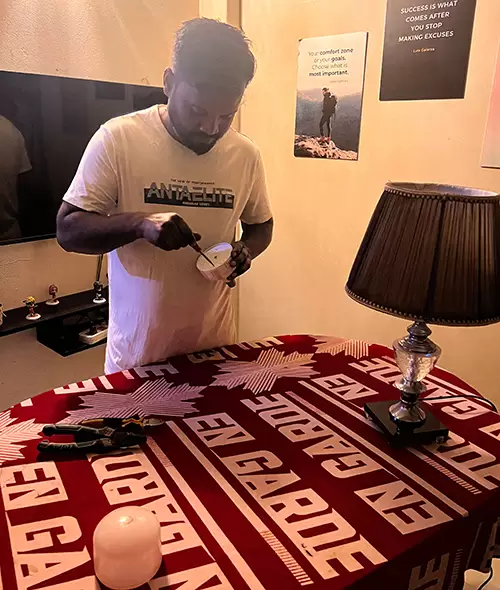
I am Mark Braeden, a professional electrician based in California. With over a decade of experience in the electrical industry, I have launched this website with the aim of sharing my expertise and providing solutions to common lighting issues that can cause frustration for homeowners.
Whether you need help selecting the right bulb for your living room lamp or require guidance in installing LED strip lights, I am here to assist you.
But it’s not just about fixing problems. I’m also here to inspire you with all sorts of creative lighting ideas that can transform your home.

